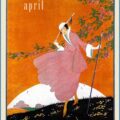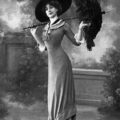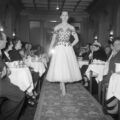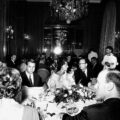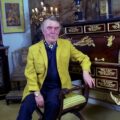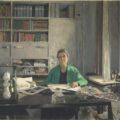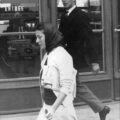Womens fashion 1917 – The new House of Paquin
May 26, 2016The war did not stop womens fashion 1917 and the trade of Parisian couture houses, although in Britain inflation had increased massively, but then again women, some for the first time, had money to spend – spare money even. To the disgruntlement of some in the press and the upper classes for whom fur was their singular domain, Munitionettes working in factories spent their pay packets on fur coats and other luxuries previously out of their reach.
I don’t know whether they took it so far as to travel for Paris for couture as society ladies did though, I imagine the upper crust were safe there. Fur, after all, was not just a status item but a practical one in the days before central heating.Besides which, the couturiers were immensely snobbish, and didn’t sell their clothes to just anyone, even if they could pay.
Remember that scene in Pretty Woman where the prostitute is turned away from the designer shop? And when it was rumoured that a certain designer requested Spice Girl Victoria Beckham not to wear his designs, before she became Top Designer Victoria Beckham and everybody swooned over her good taste? It’s been that way for hundreds of years.
House of Paquin
One designer, however, who welcomed one and all was Jeanne Paquin and her House of Paquin.
Jeanne Paquin was very unusual: call her the first Coco Chanel if you like. She was the designer and personality behind her own brand; in an era where the couturiers were mostly men and if you were a woman you were a seamstress, not a star, she stood out. She always wore her own designs to destinations quite as glamorous as her client’s, was renowned for her graceful figure and beautiful face, and even had a wax mannequin modelled on herself to stand in her shop window and show you how Mme Paquin would wear it.
Womens fashion 1917- The new House of Paquin
The House of Paquin was opened in 1891, not by Jeanne but by Isidore Rene Jacob, the man she married one month later. He had already been a partner in a couture business called Paquin Lalanne et Cie for two years, but the new House of Paquin was completely different – his wife was to be head designer and he was the business brains. Isadore legally changed his surname to Paquin eight years later and Jeanne, born Jeanne Marie Charlotte Beckers had taken the name of Paquin on her marriage, since Isadore was already using it by then.
Womens fashion 1917 – a successful business
Jeanne had been trained in a dressmaker’s shop as a young girl and then worked her way up to joining the seamstresses at Maison Rouff, a prominent Parisian couturiers.
The husband and wife team soon opened another branch of Maison Paquin in London and then also in Buenos Aires, New York and Madrid where the original Parisian designs could be made up locally. This was totally a first. The London branch even had its own special sportswear department. At its height the business had more than 2,000 employees worldwide.
Womens fashion 1917 – crazy marketing exploits
The House of Paquin was known for its marketing exploits. Mme Paquin would lead a gaggle of models dressed in the latest collections to the races, to the opera and to desirable restaurants. She caused the public quite a shock when her girls were seen on the streets of New York in matching mauve and pink wigs!
She loved colours, working skilfully with layering diaphanous fabrics and lace in different tones to achieve a shimmering effect, sometimes in harmonious tones and sometimes contrasting, sometimes over black for a dramatic effect. She also pioneered the use of black as a chic fabric, rather than one with overtones of death and mourning – she personally was often seen in crisp black and white, and she loved to add richly coloured, jewel like silk linings to sombre black coats and cloaks. She had a favourite shade of scarlet pink that became “hers”, a recognisable colour like Yves Klien blue.
“[Sometimes] … it is the material that inspires me. But I get inspiration everywhere. When I am travelling or walking in the street, when I see a sunset with beautiful blendings of colour, I often get an inspiration that helps me to evolve new combinations.… Our work in some respects resembles that of the painter.” she commented in Designs and Publicite, 1913.
Womens fashion 1917 – fur accents
The house was also known for its use of fur as a fabric in itself that could be played with. Rather than as, for example, a coat or stole made entirely of fur the House of Paquin often used it as an accent or in fine strips as contrast or piping. She often juxtaposed unexpected fabrics in this way, heavy with light or textured with smooth, but her lightness of touch meant that the result was never jarring. Chanel was renowned for using black much later, in the 1920s, and Sonia Delaunay made patchworks of colour and texture a bit like this, again in the 1920s, and Elsa Schiaparelli had her “Shocking Pink” in the 1950s, but here was Jeanne Paquin, doing all of those things first.
She is often mentioned alongside Paul Poiret around this period, the 1910s – 1920, because both had been delighted by the performances of the new and startling Ballet Russe and Léon Bakst’s “Oriental” designs for it which were an explosion of bright colours and new shapes – loose draping, veils and harem pants. This influence is clearly seen in these drawings for womens fashion 1917.
Womens fashion 1917 – brown paper paintings
These images, just some of the Autumn Winter 1917 collection, are not the most arresting but bear scrutiny. Sorry about the brown paper background – white is of course easier to see and there are some lovely earlier records on creamy white card, but presumably paper rationing had hit Paris, even if the designers could still get hold of their lace and silk. In addition this time only the garment in question – the coat or the dress – has been sketched and coloured in detail and the rest of the outfit left as a suggestion. Maybe this is again war time restrictions on artist’s materials or maybe just the artist’s style.
Womens fashion 1917 – a record
This is a formal record of the collection, not the designer’s hasty sketches, executed as inspiration struck and may not have even been in Mme Paquin’s own hand. It was very common to employ professional illustrators just to sketch the designs for the house records. There are also some photographic records of the same collection, but strangely they don’t match up to the drawings! This could have been because clients often changed an outfit to their own specifications, lengthening skirts or sleeves and changing trims and colour, so that could have been the reason for the disparity, or perhaps it is in addition to the drawings.
Most of the drawings have a name, such as “Mabel” or “Majestic”, but the photographic example just has a number – “79” – which suggests that the entire collection would have been composed of quite a large number of different garments.
Womens fashion 1917 – loose dresses
Both a feeling that masses of lace and froth were inappropriate at these sad times and also the lack of availability of lace and froth, coupled with women demanding greater practicality from their clothes as so many more were working now combined to make a simpler, looser and shorter silhouette in womens fashion 1917.
Paquin’s designs follow suit, at least in terms of length and looseness. The skirts fall to low calf, a little longer than most at this time which were an inch or so shorter, the waistline is mostly on the natural waist, sometimes a little higher or dropped a little, and the fabric flows around the body, rather than being tightly tailored. Despite this, it is very clear from the photograph that a corset, a long line one, is being worn beneath. As well as this the drawings show that Paquin wasn’t abandoning her layers of silk and lace – the shimmering lace overlay in these costumes is similar to this earlier pre-war design of 1913.
Fancy furs
Neither has her signature use of fur as trimming and punctuation apparently abated: here is appears not only several times at collar, cuffs and hem but also as a sash and panniers on this design. Fashionable war-time furs included beaver, ermine, fox, skunk, seal, musquash and even wolf and I can see Paquin has used several different types here. Usually rabbit fur, as one of the cheapest furs, was looked down upon somewhat but having proclaimed it “all but extinct” in December 1916, monkey fur having tickled the fashionable fancy instead, Vogue of December 1917 reports that rabbit fur is back, very short this time – “it’s been clipped, in fact”.
Womens fashion 1917 – forbidden feathers
This design boasts a collar so fluffy that it might be feathers rather than fur. Whilst Great War fashionistas were quite blasé about fur, seeing it as a chic necessity, and never minded the gaze of stuffed foxes heads or the tiny dangling paws which were so often retained as part of a stole, there was rising concern about the potential extinction of exotic birds who were routine plundered for their plumage to add drama to hats or fluff to feather boas. The Plumage Bill was a hot topic, debated both in and out of Parliament.
Womens fashion 1917 – awards season
Jeanne Paquin was given so many awards that anyone would be more than proud, but particularly the fact that they were given to a woman is almost astonishing. In 1900 she was chosen by her fellow couturiers to head the display of Parisian Couture at the great Paris Universal Exposition. In 1910 she was awarded the Order of Leopold II of Belgium, in 1913 the Légion d’honneur in the field of commerce, and in 1917 elected President of the official union of Parisian couturiers, the Chambre syndicale de la couture.
The end of the House of Paquin
Isadore Paquin died unexpectedly in 1907, and Jeanne Paquin headed the company alone until 1911 when her half-brother and his wife, Henri and Suzanne Joire, joined her as partners. Although she retired in 1920 the House remained open under a series of new head designers, merging with The House of Worth in 1954. In 1956 Worth-Paquin closed.




